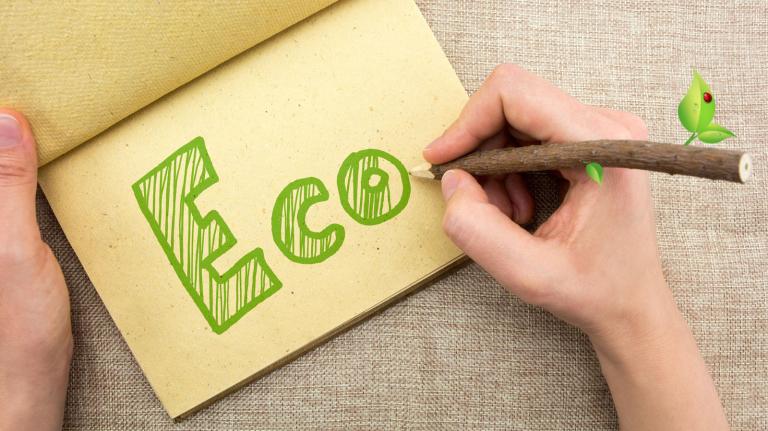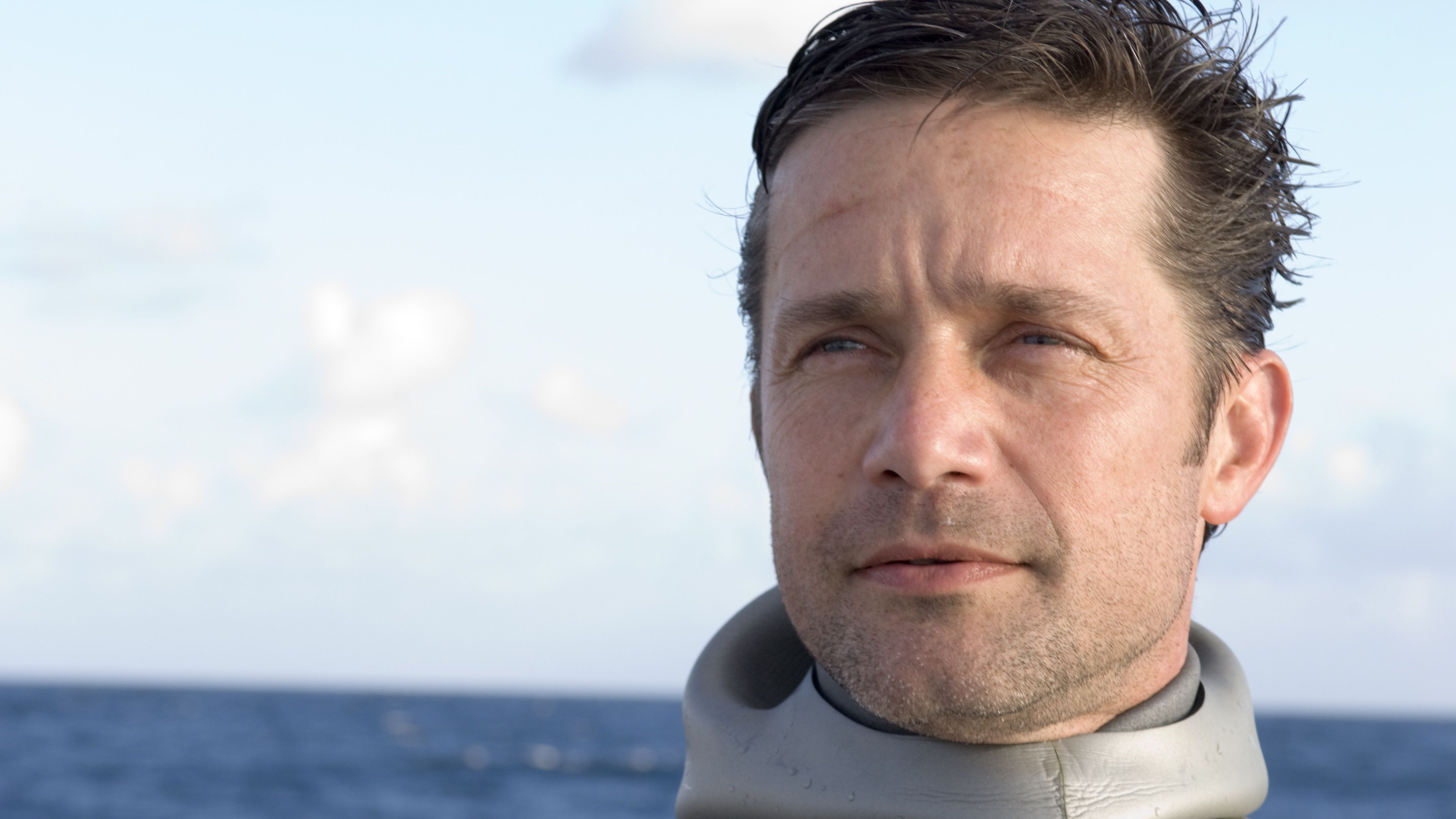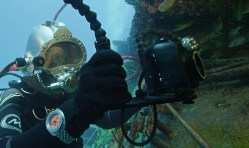That Fabien Cousteau would become an ocean explorer may have been preordained.
Fabien’s grandfather, legendary adventurer Jacques Yves Cousteau, invented the Aqua-Lung, opening the oceans to human exploration. His father, Jean-Michel, founded the Ocean Futures Society and produced the 2006 documentary Voyage to Kure which inspired then president George W. Bush to create the enormous Papahānaumokuākea Marine National Monument, the nation’s largest protected area. (Jean-Michel also appeared in both Finding Nemo and The SpongeBob SquarePants Movie DVDs which, we can all agree, is also pretty big.) Fabien’s sister Celine is a filmmaker, activist, and presenter, continuing the family legacy of undersea education.
If the ocean had a World Series, a Cousteau would throw out the first pitch, so it’s no surprise that Fabian has made quite a splash.
Fabien first reached national prominence in 2005 when, inspired by a Tintin comic book, he created a shark submarine to swim amongst great whites in an attempt to capture more natural shark behaviors and apparently prove that he is either very brave or totally insane. His latest adventure took him to Aquarius Reef Base, an undersea laboratory owned by NOAA and operated by Florida International University. The tiny habitat is currently located four miles off the coast of Key Largo in the Florida Keys National Marine Sanctuary, 66 feet beneath the waves on the continental shelf — and, shockingly, not in a James Bond movie.
Cousteau and his Mission-31 crew spent a record 31 days living and working in Aquarius. Living in a pressurized environment, Cousteau and his team of aquanauts were able to spend an unprecedented amount of time diving, performing experiments focused on climate change and ocean acidification, and, perhaps most importantly considering his family tradition of bringing the ocean world to the landlocked, filming for an upcoming documentary on the project.
“I’m not a scientist, I’m a story teller,” Cousteau told me recently, “and if we as storytellers don’t find a way to connect with the average person who doesn’t know about the oceans, then we’ve squandered an opportunity. People protect what they love.”
Q. So, you spent 31 days at the bottom of the sea. Um. How do you feel about that?
A. (Laughing) Judging from your question, you find that to be a little strange.
Q. Not many people can say that they’ve done it.
A. For me it was a bit of a bittersweet moment when I had to leave again. It was an epic expedition. To be able to live with people beneath the sea for 31 days — that was pretty thrilling. Aside from that, we were able to gather over three years of scientific data related to acidification and climate change in just 31 days. To be able to film and do science under water — the best way to do that is to live in the environment you’re trying to study. Pragmatically, you wouldn’t be able to do this research from any other platform.
Q. So, Aquarius — what is the physical space like?
A. The space, the habitat, is about the size of a school bus. It’s 43 feet long by nine feet wide, crammed full of equipment and six people. It’s been down in the water long enough that now it’s become part of the coral reef. It’s an artificial reef and, dare I say, healthier than the reef around it. There’s so much sea life around it that just exploring Aquarius itself is a fantastic display of life.
Q. I must ask: 31 days, six people, in a school-bus-sized thing — day 20, what’s the smell?
A. (Laughing) Well, it’s a full month in a very small environment, but the idea is not to be in the environment but to be out there diving — and we did dive, six, eight, 10, 12 hours a day. So you’re wet and you’re immersed in saltwater, which is a natural anti-bacterial. We certainly weren’t allowed to have antiperspirants and stuff, so that was a little bit of a challenge, but the reality was it didn’t smell half as bad as I’d thought. The pressure affects our sense of smell, it dulls it, which was probably a good thing.
Q. You were shooting a documentary while you were there. Assuming no smellevision, what were some of the new technologies you were using?
A. We had a handheld 3-D sonar system, that basically gives us a video image through acoustics, so quite literally we were able to see and to film without light. We also had a high speed-camera built by MIT engineers called an edgertronic that can shoot up to 20,000 frames per second. It allowed us to capture things far faster than the human eye that had never been filmed before.
Q. Now that you’ve looked at this film, have you seen anything that really has surprised you?
A. Oh there were a lot of surprises living on this oceanic frontier and being accepted by the residents as neighbors — things like seeing Christmas tree worms spawning at night, or a goliath grouper strike a barracuda. We were just there at the right place at the right time and there for a long time.
Q. Did the grouper eat the barracuda?
A. I think it was more of a territorial behavior. The barracuda came too close and the grouper just struck it. It happened so fast that we literally had to watch it again in slow motion to be able to see what had just happened. We were all just, wow, our jaws dropped, like, ‘Holy crap!’
Q. The rumble of a goliath grouper is one of the most amazing things I’ve ever experienced.
A. Goliath grouper are highly endangered. The only place in the world where they’re successfully protected is South Florida. To live amongst them was amazing. At night we’d be laying in our bunks and hear them boom
Q. I know you were focusing on acidification and climate change. What were the experiments you were working on?
A. We had several experiments going on at the same time [and] we were able to use a lot of equipment that’s normally used in the laboratory that we were able to use down below. For example, we had a very sophisticated 100-nanometer glass probe that has to be set and monitored with a microscope. I had a hard time rapping my head around it — it’s thinner than a human hair, it’s very, very delicate. It has to be that thin to get inside the coral without harming the animal so we can get accurate readings of dissolved oxygen, dissolved CO2, pH balance, all of those things that trigger different events within a coral from feeding to spawning to the expelling of its own zooxanthellae — the pulpy fleshy part of the coral.
In a bleaching event, when the pH is knocked off kilter or the temperature goes beyond its tolerance, the zooxanthellae expel themselves and go for a swim. The longer and harsher those swings in PH and temperature, the more likely those corals will bleach permanently. Those studies are really important to monitor on a long-term basis, because that gives us the opportunity to learn what happens and why it happens. And because we were there, right on the reef, 24-7, we were able to not break too many of those thousand-dollar probes.
At the same time we were studying predator prey behavior and we’re seeing that a reef with a healthy amount of herbivores and predators is less susceptible to bleaching. When pH goes up, when temperatures go up, it triggers algae blooms. These blooms are kept in check by the lawnmowers of the sea: urchins, parrot fish, and the like. The more we take away those animals on the reef, the less the reef is able to combat that problem and those algaes which are faster growing than corals and sponges will take over a reef and smother it.
There’s a real symbiotic relationship at work, and we’re over fishing these reefs. It’s another negative effect on reefs already under siege by acidification and bleaching. It’s like a four-legged stool: You can knock one off but if you knock off another you hit the floor. Acidification is a huge and it’s global, but on top of that, the reef fish are fished out. You’re knocking the second leg off the stool.
Q. As far as acidification on the reef, how do the Florida Keys look?
A. I’ve been diving these reefs for almost 40 years and The Florida Keys, just like everywhere else in the world, have changed drastically, especially in the last 20 years. I can’t paint a positive picture, unfortunately. There’s still beauty, but the difference is astounding. If you look at a place that’s less susceptible to overfishing, such as The Garden of the Queen in Cuba, it’s in the same area, it has the same global pressures of acidification and climate change, but because it’s completely off limits to any kind of fishing, you have a healthy population of reef animals and the corals themselves are doing much better.
A healthy coral reef is a fireworks display of life. The fish — the density is amazing. The colors on the bottom, the shapes, the variety, the difference between that and an unprotected or even partially protected reef, they get a heavy, heavy impact. The bottom, the topography, you can see the stony part of the coral, just skeletal structure, it’s night and day.
We need marine sanctuaries that are 100 percent off limits to fishing. People who do fish can fish the boundaries and enjoy the benefits of a healthy reef.
Q. What do you think is the most important thing that people can do to help stem climate change, to help save these reefs?
A. I think we have to remember it’s not about saving reefs or hugging dolphins or anything like that. It’s about saving our own asses. We know what we’re doing to the planet and it’s our life-support system. We need to look at it as a natural resource bank account and start living off the interest instead of eating away what’s left of the capital.
If we stop living on this planet and start living with it we’ll have a far better chance of survival. The planet doesn’t care about us, but we need to care about it.








